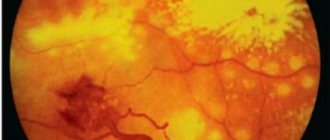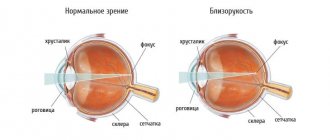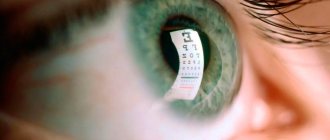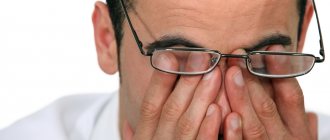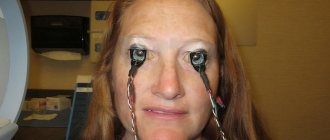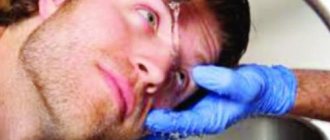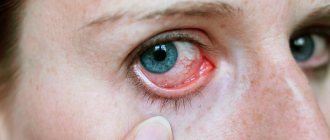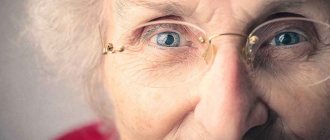Amblyopia, or lazy eye syndrome, is a condition in which one eye sees worse than the other. If this condition persists for a long time, it can eventually lead to strabismus, as well as deterioration of vision in the weak eye. Amblyopia is the most common cause of poor vision in children. There are many methods of treating this disease; exercises help with amblyopia. Children respond better to treatment than adults.
Problem Definition
Normally, the retina of the eye is formed and trained by a constant flow of light information. It enters the visual parts of the brain through the nerves and is processed there. Central vision depends on the state of the foveal region, which is finally formed after the birth of the baby.
Amblyopia is a deterioration of central vision in one or both eyes, without obvious organic lesions of the canals and retina. It is popularly known as “lazy eye”. The eyes provide the brain with inconsistent information. Disturbances occur specifically in the visual areas of the neocortex. The brain cannot form a single picture of reality.
The signals compete with each other, and the weaker eye gives up and stops participating in the vision process. The child has difficulty navigating the world around him and becomes clumsy. New neural connections responsible for vision are inhibited.
So even getting rid of the sources of the disease sometimes does not allow you to return image clarity. You can't delay treatment. In this case, pathology in one baby will arise with a difference in the eyes of one diopter, while in another the brain successfully copes with a difference of several diopters.
Types of pathology
The primary form includes anomalies caused by a violation of the refractive function of the eye. They happen on one eye, on both eyes at once, coordinated or asymmetrical. Three-dimensional vision may also be impaired due to strabismus. Inconsistency in the work of muscles in the eyes appears due to farsightedness, injuries, and mental problems.
This form affects the squinting eye more. Anisometropic amblyopia is caused by a mismatch between the refraction and image size of the eyes. Combined pathology combines the problems described above. With severe shocks or disturbances in the central nervous system, hysterical amblyopia may develop.
If amblyopia in a child was cured, but returned again, we are talking about a secondary form. This may be deprivation amblyopia, which makes it difficult for images to appear on the retina. Its causes: opacities on the cornea, cataracts, drooping of the upper eyelid. If the conductivity of the optic nerve is disrupted, a neurogenic type of illness may occur.
Retinal pathologies can cause a maculopathic form. Nystagmic amblyopia is caused by uncontrolled vibrations of the eyeballs. The above mentioned problems can be combined, then we are talking about a combined pathology.
Prices for diagnostic services and consultation with an ophthalmologist
| Type of medical service | Service price in rubles |
| Complete ophthalmological examination | 1000 |
| Complete ophthalmological examination of children | 1100 |
| Fundus examination | 900 |
| Consultation with an ophthalmologist for eye disease in an adult | 500 |
| Consultation with an ophthalmologist for eye diseases in children over 3 years of age | 700 |
| Selection of simple glasses with a prescription | 500 |
| Selection of glasses for astigmatism with a prescription | 700 |
| Selection of contact lenses with training and prescription | 1000 |
Treatment methods
Hardware treatment of eyes in children
Treatment with ophthalmological devices makes it possible to achieve a lasting therapeutic effect in young patients. In some cases, it is possible to completely get rid of pathologies such as amblyopia, impaired binocular vision, and false myopia.
Complete ophthalmological examination of children
Does your child complain of pain in the eyes, difficulty seeing surrounding objects, or squinting? Are your eyes often red? You definitely need to undergo an examination that will help you choose the necessary methods of therapy.
Ophthalmological device "Cascade"
Impact on the visual function of the eyes with light and color stimuli that dynamically move over a certain distance in a closed tube. Particularly effective for accommodation disorders and restoration of binocular vision.
“Spekle M” device: what is it used for and what does it treat?
The device is used in the general treatment program for amblyopia, myopia, and hypermetropia in children, regardless of the cause of the disease. The therapeutic effect is based on exposure to infrared laser radiation.
“AMO-ATOS” device and attachment to the “Amblio” device
The device affects the organs of vision using magnetic stimulation. The effect of a traveling magnetic field with the projection of light stimuli onto the retina of the eye has a healing effect in the presence of ametropia of the eyes and the presence of inflammatory processes.
This is interesting
Features of the use of contact lenses by children and adolescents
What diseases can be diagnosed based on the condition of the eyes?
Preserving vision and eye health with Crizal Eyezen lenses
Protect your eyes from the sun with UV filter contact lenses
Which spectacle lenses should I choose? Choose your glasses with Crizal Corner
Causes of the disease
Both children with a hereditary predisposition and those without such cases in the family history suffer from the pathology. With a “lazy eye,” visual acuity deteriorates, its stereoscopic properties are disrupted, and ocular fixation is weakened or absent.
Let us note the prerequisites for visual impairment:
- Different eyeballs.
- Obstructions to light rays reaching the retina (vitreous pathologies, corneal opacities, cataracts).
- Severe farsightedness or astigmatism in one eye.
- Strabismus.
- Release of blood into the vitreous body or into the cavity around it.
- Severe stress and mental stress, complicated by psychosis or hysteria.
Be attentive to the visual system of children if they were born premature, are being observed for delays in mental development, or have genetic diseases (asymmetrical facial hyperplasia, strabismus, Kaufman syndrome, paralysis of the extraocular muscles with drooping eyelids and dilated pupils).
The disease makes children clumsy, slow, and unsure of their movements. They have poor body control and get lost in new locations. It is typical for them to try to look at something, turning their heads in search of the right angle.
If a baby was born with vision problems, he cannot talk about it, because he does not know that it can be different. So try to check your baby's vision as early as possible. And do it regularly.
Expert recommendations
- The earlier the syndrome is identified, the more successful the treatment will be.
- Therapy carried out before the child reaches nine years of age is considered effective.
- Even vision at the level of ten percent does not affect the child’s behavior. Only a doctor will make the correct diagnosis and prescribe appropriate treatment.
- It is necessary to show the child to an ophthalmologist as soon as he is one month old. If the baby is premature or born with abnormalities, then it is recommended to carry out the examination even earlier. From four to twelve months the refractive power of the eye should be checked. The norm is slight farsightedness. Then inspections should be carried out once a year.
Clinical picture of the disease
Most often, visual impairment in children is caused by secondary amblyopia with impaired refraction and binocular vision. The early stages of this pathology occur with virtually no external manifestations and cannot be diagnosed independently.
The most obvious sign of complex forms of the disease is severe strabismus and instability of the eyeball.
There are factors the presence of which should make you want to check your little one’s vision.
These include:
- uncontrollable twitching of the eyeballs;
- strabismus;
- Difficulty when trying to keep your gaze on a bright object.
For growing children, the following symptoms will be alarming:
- uncorrectable drop in visual acuity;
- problems with orientation in a new area, accompanied by a lack of coordination;
- the desire to close one eye when looking at something;
- difficulties in learning new material;
- bending and turning your head for better visibility;
- misalignment of the eye, mismatch between the position of the eye and the direction of gaze;
- dark blindness and problems with color perception.
Symptoms of a lazy eye
Knowing what amblyopia is and how it manifests itself is important for all parents. Clinical manifestations and symptoms of the pathology depend on the cause of its development. Obvious signs of the development of the disease are ptosis, cataracts, and cataracts. Their presence can be noticed by a neonatologist immediately after the baby is born. If these problems exist, the child is prescribed a consultation with an ophthalmologist in order to identify and prevent the development of amblyopia.
If there are no obvious signs, it is quite difficult to notice the development of amblyopia in a small child.
Parents should pay attention to the following behavior of the child:
- disturbance of orientation in an unfamiliar space;
- clumsiness of movements. A small child often misses when trying to take a toy offered to him.
- deviation of one eye when watching TV, reading;
- the child’s desire to cover one eye with his hand or squint;
- turning, tilting the head when examining objects;
- different eye behavior: if one eye moves while the other remains motionless;
- color vision impairment;
- poor orientation at dusk.
ARTICLES ON THE TOPIC:
- What is amblyopia in adults and how to treat the acquired syndrome...
- What are the types and severity of lazy eye syndrome?
- The most effective computer programs and hardware methods for treating amblyopia...
IMPORTANT! The first symptom that should cause concern in parents is the child’s rapid fatigue during classes, the appearance of headaches and pain in the eyes when reading, drawing, or watching TV.
Warning signs indicate that the child is developing lazy eye syndrome. In addition to monitoring the baby, an examination at an ophthalmology clinic helps determine the presence of pathology. A screening examination is recommended for all children before entering school.
However, to identify problems earlier, experts recommend screening at the age of 3 years. The most informative method for examining young children is photoscreening, which is the recording of pupil reflexes and the symmetry of their reflection in photographs.
The disease can also be diagnosed using methods for recognizing letter optotypes or picture optotypes. To evaluate patients with strabismus, the doctor performs a test to determine the ability to maintain fixation on an image in each eye.
Diagnostic measures
A newborn baby is immediately examined by a neonatologist. If any congenital anomalies are detected, he refers the baby to an ophthalmologist.
The disease can also be detected during an examination by an eye doctor. The ophthalmologist checks the eyelids and palpebral fissure, the shape and position of the organ. Examines the fundus of the eye and its vessels, retina, optic nerve head. Examines ocular structures in detail using a slit lamp.
Evaluates how pupils react to direct light. The doctor tests the patient to determine visual acuity and color discrimination. Defines the boundaries of a part of space accessible to the eye when the gaze and head are stationary with a projection onto a spherical surface. Checks the vitreous body and lens.
If opacification is present, ultrasound is added to the diagnostic measures. The doctor also calculates the angle of strabismus and measures intraocular blood pressure. To assess the performance of the retina, light pulses are applied to it and the resulting bioelectric potentials are measured.
There is a four-point color test to determine whether three-dimensional vision is functioning normally. Objective refraction of the eye is measured with refractometers. Based on the results, an additional appointment with a pediatric neurologist may be necessary.
Leading specialists
Shchipun Sergey Konstantinovich Director of the Center, Chief Ophthalmologist of the highest category, Candidate of Medical Sciences More about the specialist
Ganichenko Irina Nikitichna Ophthalmologist of the highest category, leading retinologist, candidate of medical sciences More about the specialist
Vladilena Vladimirovna Koroleva, ophthalmologist of the highest category, Candidate of Medical Sciences More about the specialist
Treatment methods
Treatment of amblyopia in children must begin before the age of seven. After twelve years, treatment no longer brings results. First you need to remove the source of the disease. It could be:
- Surgical removal of cataracts, eyelid correction. Ideally, up to six months, but this is not always possible. It is important to do it in the period from four to six years.
- Therapy to dissolve disorders in the vitreous body or their microsurgical removal.
Surgical and therapeutic correction of strabismus:
- restoration of the function of the macula of the retina by laser exposure, using computer programs;
- use of devices and software;
- diploptics;
- special gymnastics for the eye muscles.
Strabismus must be treated, and the sooner, the more effective it is.
Refractive or anisometropic amblyopia in children is treated with the correct selection of glasses or lenses and corrected with laser. This is followed by pleoptic treatment, which is carried out on average three times a year.
The healthy eye is closed, and the damaged one is exposed to light, electrical impulses, or trained using certain computer programs. Passive training takes place on a special device under the influence of light, electricity, laser, vibration, etc.
Deeper treatment
The next stage of therapy involves adjusting three-dimensional vision. Mandatory prerequisites for this must be vision of at least 0.4 and age at least four years. Using an orthoptic synoptophore device, children are taught to combine different parts of one picture into a single whole. Then the effect is consolidated with exercises to overcome the splitting of the picture.
Children younger than this age are treated with deliberate suppression of the visual function of the healthy eye. A special solution is dripped into it so that the weakened eye takes over the function and begins to recover. Side effects of this treatment may include redness and irritation of the eye, and headaches.
From the age of 4 you can try the method of direct or reverse occlusion. In the opposite case, the problem eye is glued shut. In the direct case, the eye is working, forcing the organ with the defect to participate in the visual function.
The closure of the eyes alternates. According to the doctor's indications, you can walk with your eye taped permanently, partially or minimally.
It is important to note the disadvantages of this treatment method. Due to the dishonesty of parents and doctors, the onset of pathology in a healthy eye can be missed. Strabismus and double vision may occur or worsen.
The skin under the pad may become irritated or have an allergic reaction. The effectiveness is also low due to the child’s reluctance to constantly walk with one eye closed.
Additionally, physiotherapy is used:
- multi-frequency vibration massage;
- acupuncture;
- administration of drugs through the skin and mucous membranes with direct electric current.
The hysterical form involves psychotherapy and the use of sedatives.
In case of dysbinocular amblyopia, it is necessary to quickly fix the correct position of the eyeball. Then you can apply local stimulation of the central zone of the retina with devices and a laser beam. Various testers, stimulators, and programs are used to train the eyes.
With any treatment, the right tactics are only half the battle. You and your baby will need a lot of patience and willpower to systematically follow all the doctor’s instructions and train their eyes.
Treatment
Treatment for lazy eye syndrome depends on the cause. The goal is to eliminate it and thus restore stimulation of the visual cells.
Conservative methods of therapy
Medicines
In the hysterical form of the disease, the use of medications with a sedative effect is indicated. The patient is examined by a psychotherapist and a neurologist. They use psychotherapy methods.
Treatment with medications is aimed at improving blood supply, metabolic processes and restoring the conductivity of optic nerve fibers.
Occlusion treatment
To treat the disease, the occlusion method is used.
It is necessary to stimulate the development of the amblyopic eye while the child performs near vision exercises. The healthy visual organ is covered with a plaster that is glued directly to the skin. They wear it for a long time. The duration of such treatment is determined by the ophthalmologist. The occlusion method is used for several hours a day while the child is awake or throughout the day with short breaks.
Amblyokor-01
Treatment with this device is carried out for any form of the disease. The purpose of the device is to normalize the bioelectrical activity of the visual areas of the brain.
Amblyocor-01 is more beneficial if used in childhood. This treatment supports visual function. In combination with light, magnetic and electroacupuncture stimulation, it increases optical power by 25%.
Laser stimulation
The therapy has analgesic, anti-inflammatory and vasodilating effects. Laser stimulation allows you to restore full functions of the visual system.
Treatment is carried out in combination with drug therapy and electrical stimulation. It is recommended to undergo treatment up to 4 times a year, in courses of 10 days.
Surgical treatment of amblyopia
Surgery is performed for the obscuration form of the disease. Cataracts are removed or keratoplasty is performed at an early age.
Surgical intervention is indicated for drooping eyelid tissues and myopia. That is, it is prescribed to eliminate the root cause of the pathology. Laser therapy is most often used.
Treatment of illness with folk remedies
It will not be possible to cure the disease at home only by using folk remedies. This method is included in the complex therapy of amblyopia.
Home treatments allow you to get enough vitamins and maintain good health. Carrots, spinach, fish, broccoli and citrus fruits have a positive effect on visual perception.
Medicinal herbs are used to promote rapid restoration of visual functions. Hernia and dry eyebright are used. The herbs are poured with boiling water, left for an hour and taken before meals.
You can use ginseng infusion. It is sold at the pharmacy. Should be taken in small doses several times a day. Not recommended for children.
Exercises for better functioning of the eyeballs
If the disease is present in adults and children, special exercises are required. Thus, it will be possible to make the lazy eye work and restore its functionality.
It is necessary to perform visual exercises on the affected organ, covering the healthy one with a bandage. The child should not peep with his healthy eye; the bandage should fit tightly to the skin.
Exercises:
- look into the distance for a while, then sharply shift your gaze to a nearby object;
- follow moving objects;
- move your eyes in different directions;
- look at the bridge of your nose until your eyes get tired;
- visually draw geometric shapes.
Exercises are performed for 30 minutes, gradually increasing the time to 4 hours a day. Perform slowly, without sudden movements. Computer programs are also used. They can cure even the most severe cases of the disease.
Recommended: Strabismus, I-corrector, Crosses, Amblyocor, Reamed.
Prevention on your own
Children may not always notice decreased vision; preventive examinations are an important condition for healthy growing up. A child's visual system goes through several stages of growth and development. Visit an ophthalmologist at the following age intervals: five to seven, ten to twelve, sixteen years. Adequate load on vision and body, proper alternation of activity and rest, and strengthening of the immune system have a positive effect on the development of visual function in children.
You can constantly engage in eye prevention and training at home. Drawing, putting together puzzles, coloring books, board games with many details and elements, mosaics, construction sets, and manual exercises for fine motor skills are effective and useful.
It would be good to use the amblyostimulator for fifteen minutes every day. Ensure proper posture and conditions for reading and studying. Do not place rattles or brightly colored objects directly in front of the baby's face. Excessive physical activity can harm a baby with amblyopia, but swimming is very beneficial. The child needs to be taught how to navigate in space. The toddler's diet should be balanced and healthy.
Exercises
In each individual clinical case, treatment and training are selected individually, many factors are taken into account. Here are a number of universal exercises that are suitable for almost everyone.
Standing at the window, the baby should either bring the sheet with the text printed on it closer or further away, distinguishing the distance when it is easy to read and when the letters are no longer distinguishable.
A circle with a diameter of up to 8 mm made of black paper is attached to an electric lamp with a power of up to 70 watts. The child covers her normal eye and looks at the lamp with her bad eye for half a minute. Then he directs his gaze to a white sheet of paper fixed on a vertical surface until he sees a halo from the lamp on it.
A one-hundred-watt table lamp is covered with a black paper cap with a half-centimeter hole, which is covered with red film. The baby looks at this red dot in complete darkness for about three minutes at a distance of 40 cm. At the same time, someone must turn on and turn off the lamp itself alternately every three seconds. Try to exercise regularly for three months.
It is also useful to sometimes focus both eyes on the tip of your nose. Perform gymnastics, moving your eyes in a circle, then in one direction, then in the other direction alternately.
You can do this workout no more than once a day: sitting up straight, with your hands on your knees, look to the left and sharply down, without blinking. If lacrimation occurs, stop.
There is another exercise using a flash and a piece of paper. Half a meter from the child at eye level, we perform up to 10 camera flashes. After each use, he should try to make out the written text on paper at a distance of 1–2 meters. You need to train like this for about two months, 3 approaches a day.
Prognosis for amblyopia
The success of treatment depends on a number of conditions. Doctors promise a better prognosis if amblyopia in children is diagnosed and treated correctly before the age of seven, while the ocular system is still in its formation stage. The most severe consequences can be caused by a form of pathology that interferes with the passage of light through the eye. If refraction is impaired, a suitable correction should be immediately performed, and strabismus must be eliminated.
With a serious degree of impairment, it is easier for a child to adapt to a specialized preschool institution, where children do gymnastics, physiotherapy, and train the visual system. Specialized treatment should be continued with exercises and healthy activities at home.
Now, even high-grade amblyopia is not scary for your child. If you liked the article, don't forget to give it 5 stars!
Degrees
According to the degree of vision loss, amblyopia is weak (1st degree, 0.4 - 0.8 diopters), moderate (2nd degree, 0.2 - 0.3 diopters), high (3rd degree, 0.05 - 0.1 diopters) and very high (fourth degree, below 0.04 diopters).
Low and moderate amblyopia is difficult to determine even for doctors. High degrees of the disease are diagnosable.
The first “bell” of a high degree of amblyopia is the appearance of clumsiness in a child. Problems with visual fixation and strabismus are also common. Amblyopia can lead to low vision and even disability!
